
Health Communication 9o LAT D1R⊙V● ●SKILEUROPY .9 主讲教师:王积龙
Health Communication 主讲教师:王积龙
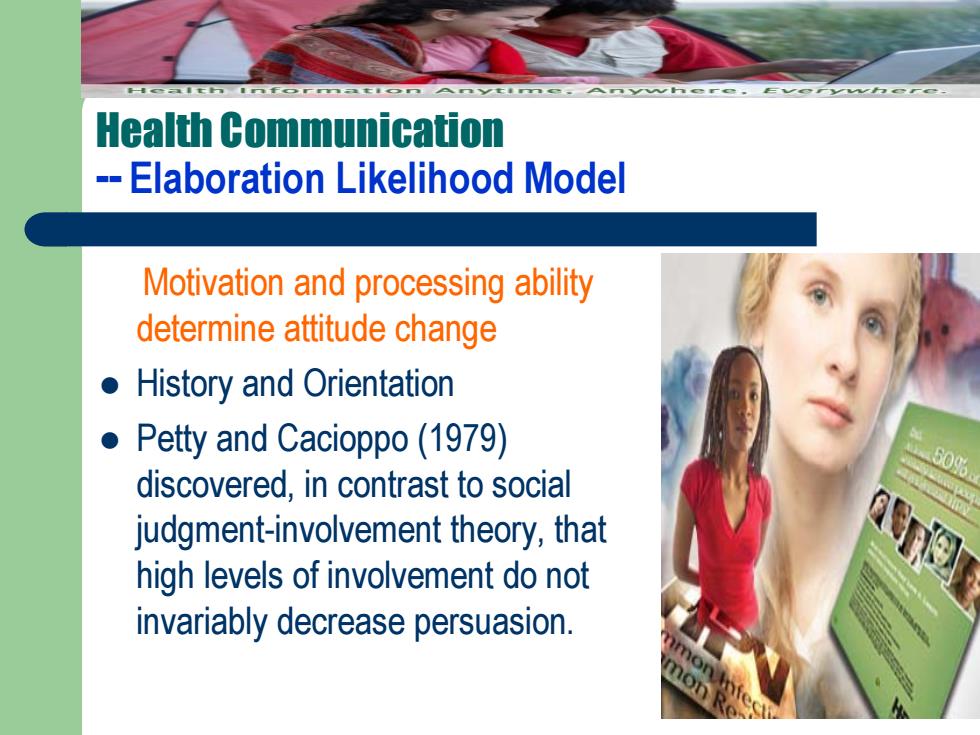
Health Communication --Elaboration Likelihood Model Motivation and processing ability determine attitude change History and Orientation Petty and Cacioppo(1979) 60% discovered,in contrast to social judgment-involvement theory,that high levels of involvement do not invariably decrease persuasion
Health Communication -- Elaboration Likelihood Model Motivation and processing ability determine attitude change History and Orientation Petty and Cacioppo (1979) discovered, in contrast to social judgment-involvement theory, that high levels of involvement do not invariably decrease persuasion
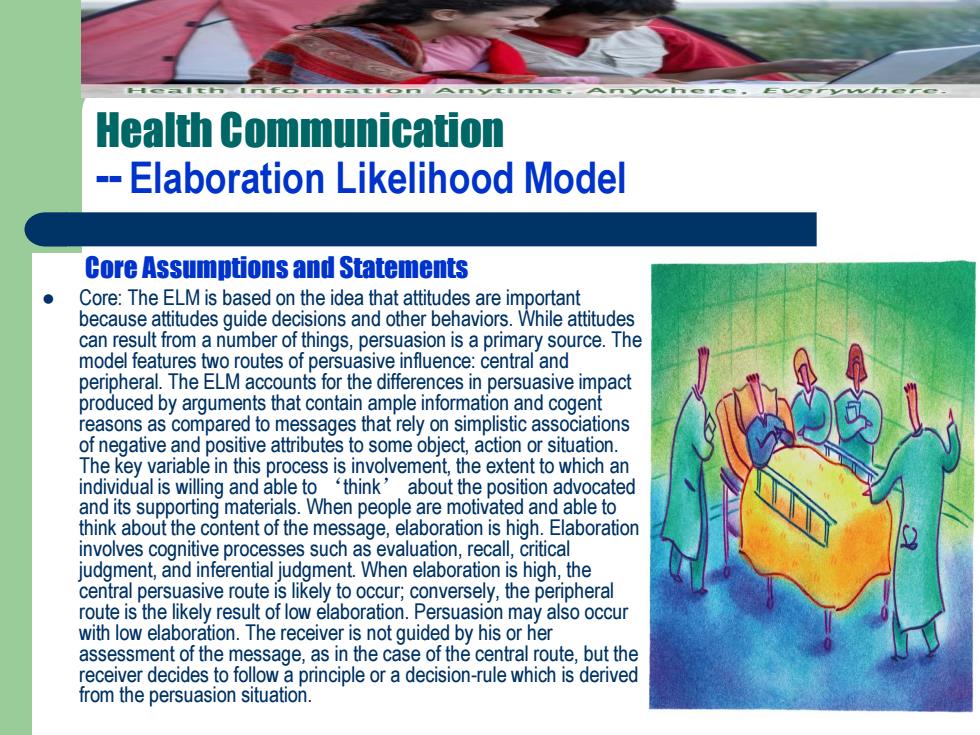
Health Communication --Elaboration Likelihood Model Core Assumptions and Statements Core:The ELM is based on the idea that attitudes are important because attitudes guide decisions and other behaviors.While attitudes can result from a number of things,persuasion is a primary source.The model features two routes of persuasive influence:central and peripheral.The ELM accounts for the differences in persuasive impact produced by arguments that contain ample information and cogent reasons as compared to messages that rely on simplistic associations of negative and positive attributes to some object,action or situation. The key variable in this process is involvement,the extent to which an individual is willing and able to think'about the position advocated and its supporting materials.When people are motivated and able to think about the content of the message,elaboration is high.Elaboration involves cognitive processes such as evaluation,recall,critical judgment,and inferential judgment.When elaboration is high,the central persuasive route is likely to occur;conversely,the peripheral route is the likely result of low elaboration.Persuasion may also occur with low elaboration.The receiver is not guided by his or her assessment of the message,as in the case of the central route,but the receiver decides to follow a principle or a decision-rule which is derived from the persuasion situation
Health Communication -- Elaboration Likelihood Model Core Assumptions and Statements Core: The ELM is based on the idea that attitudes are important because attitudes guide decisions and other behaviors. While attitudes can result from a number of things, persuasion is a primary source. The model features two routes of persuasive influence: central and peripheral. The ELM accounts for the differences in persuasive impact produced by arguments that contain ample information and cogent reasons as compared to messages that rely on simplistic associations of negative and positive attributes to some object, action or situation. The key variable in this process is involvement, the extent to which an individual is willing and able to ‘think’ about the position advocated and its supporting materials. When people are motivated and able to think about the content of the message, elaboration is high. Elaboration involves cognitive processes such as evaluation, recall, critical judgment, and inferential judgment. When elaboration is high, the central persuasive route is likely to occur; conversely, the peripheral route is the likely result of low elaboration. Persuasion may also occur with low elaboration. The receiver is not guided by his or her assessment of the message, as in the case of the central route, but the receiver decides to follow a principle or a decision-rule which is derived from the persuasion situation
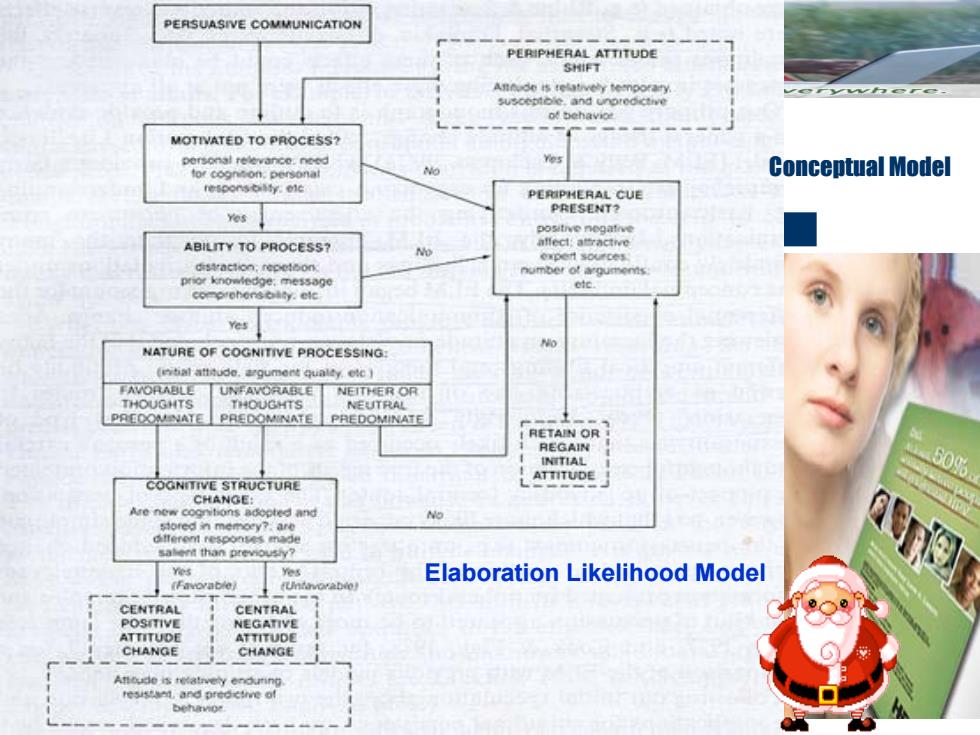
PERSUASIVE COMMUNICATION PERIPHERAL ATTITUDE 生针样于 ol behavioe MOTIVATED TO PROCESS? personal relevance:need Yes tor coonon personat No Conceptual Model PERIPHERAL CUE Yes PRESENT? positive negative ABILITY TO PROCESS? aflect:atractive 。州o0地 distraction:repetoon number of argun prior knowledge:message Yes Mo NATURE OF COGNITIVE PROCESSING LAVORABU UNFAVORABLE NEITHER OR THOUGHTS THOUGHTS NEUTRAL PREOOMINATE PREDOMINATE PREDOMINATE RETAIN OR 日ECA ATTITUDE 60% COGNITIVE STRUCTURE CHANGE: sored in memory?.are dtferent responses made a箱九n prevous小y? 阀 Yes Yes Elaboration Likelihood Model CENTR益1 CENTRAL POSTTIVE NEG去TW ATTITUDE ATTITUDE CHANGE CHANGE A韩de is end水n
Health Communication -- Elaboration Likelihood Model Conceptual Model Elaboration Likelihood Model
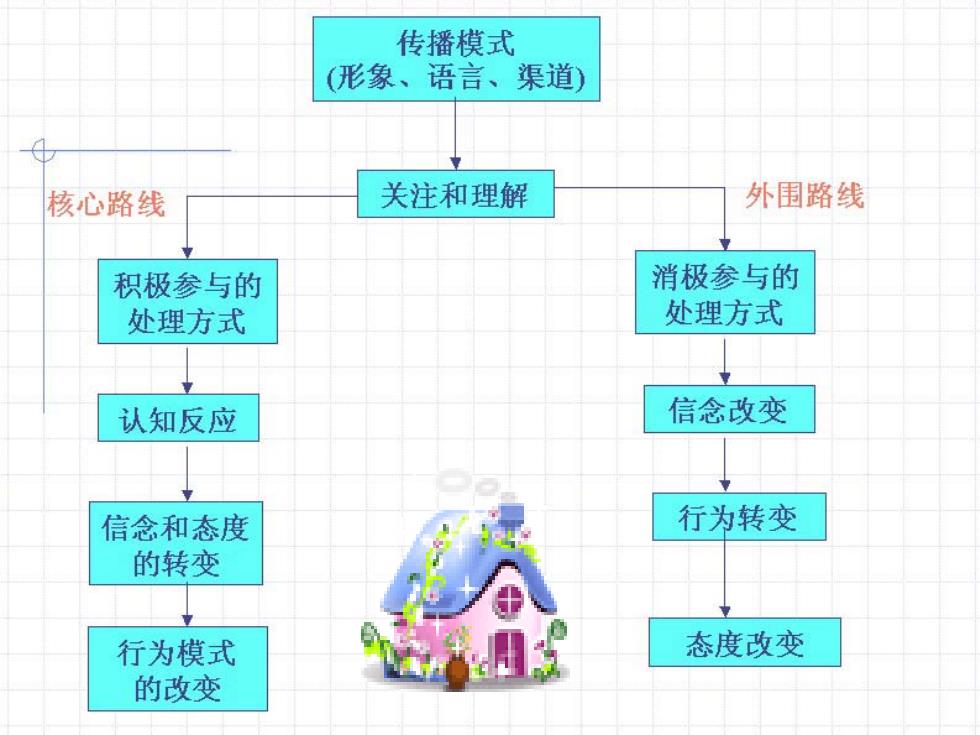
传播模式 (形象、语言、渠道) 核心路线 关注和理解 外围路线 积极参与的 消极参与的 处理方式 处理方式 认知反应 信念改变 信念和态度 行为转变 的转变 行为模式 态度改变 的改变
Health Communication -- Elaboration Likelihood Model Conceptual Model Elaboration Likelihood Model
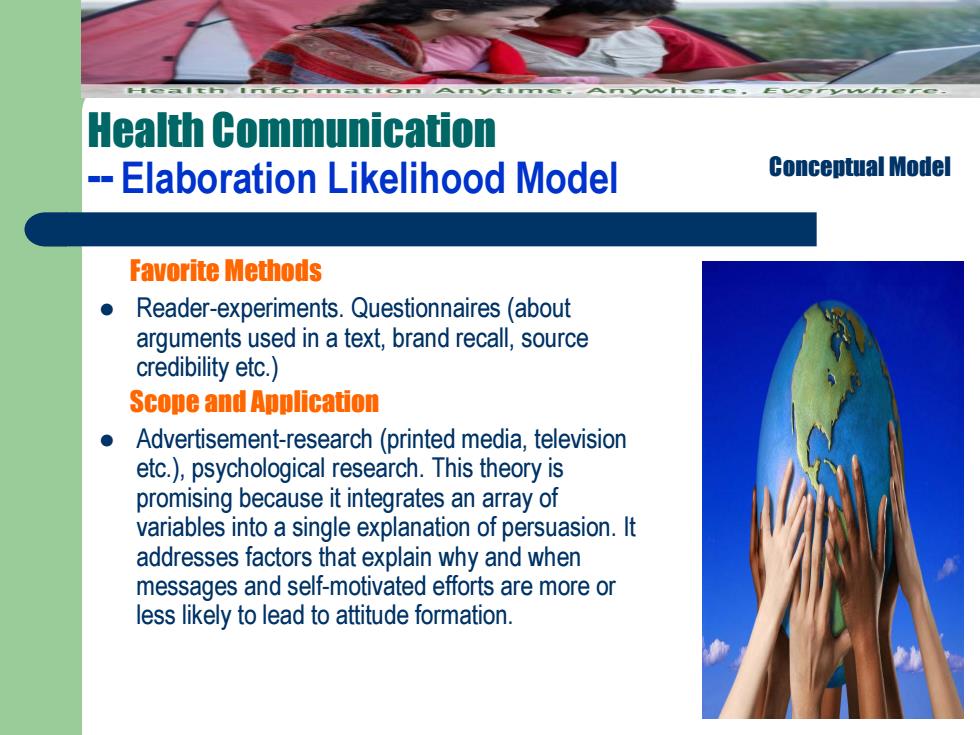
Health Communication --Elaboration Likelihood Model Conceptual Model Favorite Methods Reader-experiments.Questionnaires(about arguments used in a text,brand recall,source credibility etc.) Scope and Application Advertisement-research(printed media,television etc.),psychological research.This theory is promising because it integrates an array of variables into a single explanation of persuasion.It addresses factors that explain why and when messages and self-motivated efforts are more or less likely to lead to attitude formation
Health Communication -- Elaboration Likelihood Model Conceptual Model Favorite Methods Reader-experiments. Questionnaires (about arguments used in a text, brand recall, source credibility etc.) Scope and Application Advertisement-research (printed media, television etc.), psychological research. This theory is promising because it integrates an array of variables into a single explanation of persuasion. It addresses factors that explain why and when messages and self-motivated efforts are more or less likely to lead to attitude formation
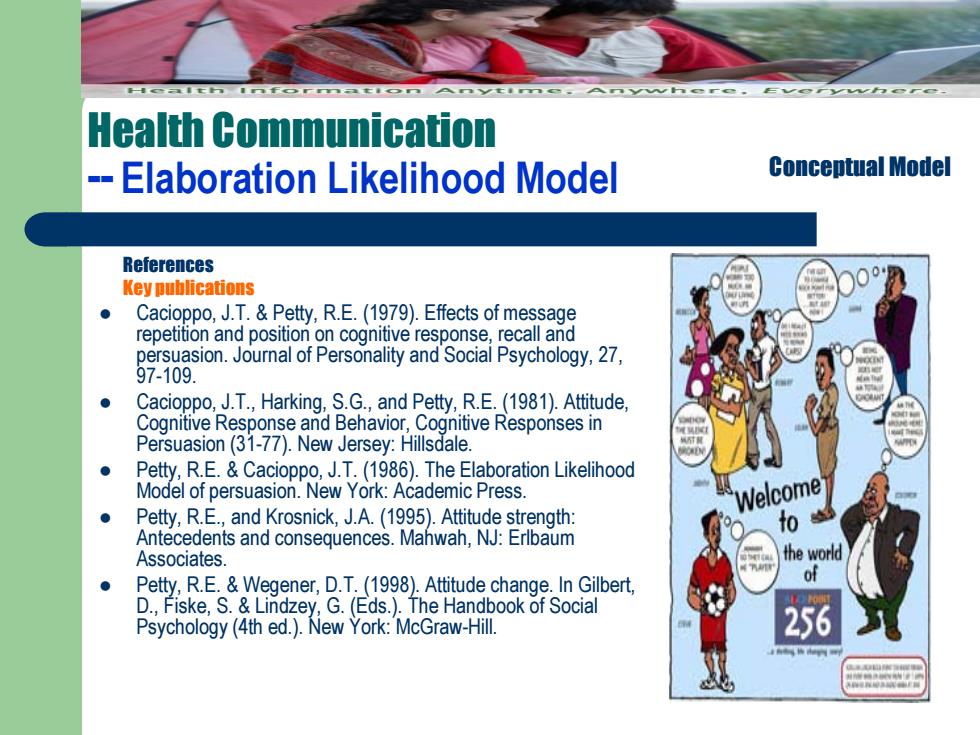
Health Communication --Elaboration Likelihood Model Conceptual Model References 00 Key publications Cacioppo,J.T.Petty,R.E.(1979).Effects of message repetition and position on cognitive response,recall and persuasion.Journal of Personality and Social Psychology,27, 97-109 Cacioppo,J.T.,Harking,S.G.,and Petty,R.E.(1981).Attitude, Cognitive Response and Behavior,Cognitive Responses in Persuasion (31-77).New Jersey:Hillsdale. ● Petty,R.E.Cacioppo,J.T.(1986).The Elaboration Likelihood Model of persuasion.New York:Academic Press. Welcome ● Petty,R.E.,and Krosnick,J.A.(1995).Attitude strength: o Antecedents and consequences.Mahwah,NJ:Erlbaum Associates. the world Petty,R.E.&Wegener,D.T.(1998).Attitude change.In Gilbert, of D.,Fiske,S.Lindzey,G.(Eds.).The Handbook of Social Psychology(4th ed.).New York:McGraw-Hill. 256
Health Communication -- Elaboration Likelihood Model Conceptual Model References Key publications Cacioppo, J.T. & Petty, R.E. (1979). Effects of message repetition and position on cognitive response, recall and persuasion. Journal of Personality and Social Psychology, 27, 97-109. Cacioppo, J.T., Harking, S.G., and Petty, R.E. (1981). Attitude, Cognitive Response and Behavior, Cognitive Responses in Persuasion (31-77). New Jersey: Hillsdale. Petty, R.E. & Cacioppo, J.T. (1986). The Elaboration Likelihood Model of persuasion. New York: Academic Press. Petty, R.E., and Krosnick, J.A. (1995). Attitude strength: Antecedents and consequences. Mahwah, NJ: Erlbaum Associates. Petty, R.E. & Wegener, D.T. (1998). Attitude change. In Gilbert, D., Fiske, S. & Lindzey, G. (Eds.). The Handbook of Social Psychology (4th ed.). New York: McGraw-Hill
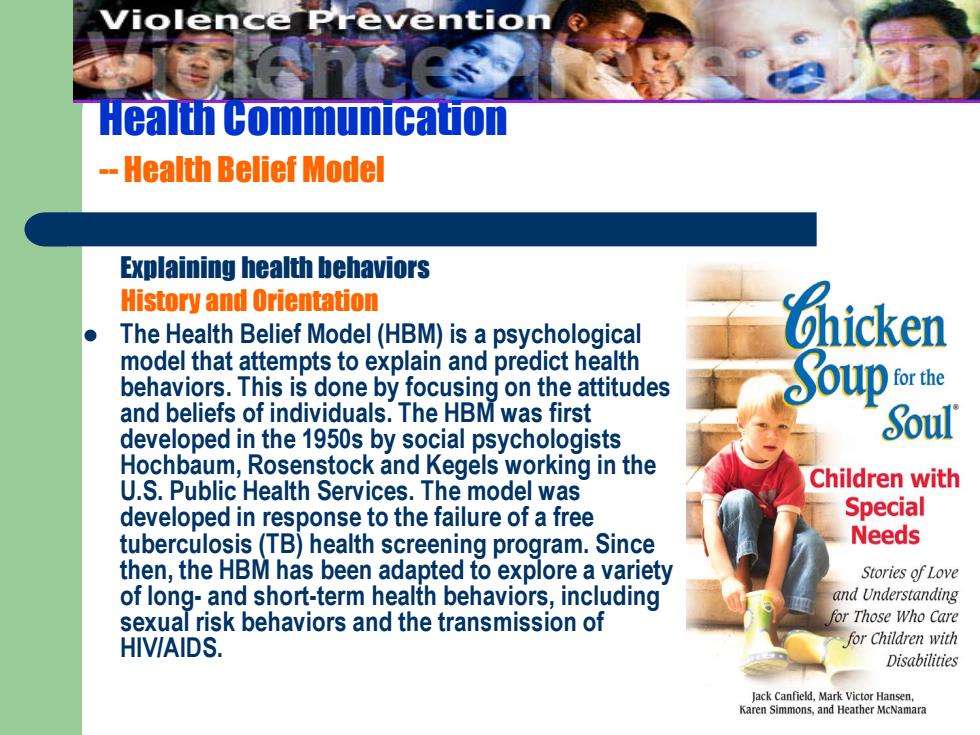
Violence Prevention Health Communication --Health Belief Model Explaining health behaviors History and Orientation The Health Belief Model(HBM)is a psychological Chicken model that attempts to explain and predict health behaviors.This is done by focusing on the attitudes Soup or the and beliefs of individuals.The HBM was first developed in the 1950s by social psychologists Soul Hochbaum,Rosenstock and Kegels working in the U.S.Public Health Services.The model was Children with developed in response to the failure of a free Special tuberculosis(TB)health screening program.Since Needs then,the HBM has been adapted to explore a variety Stories of Love of long-and short-term health behaviors,including and Understanding sexual risk behaviors and the transmission of for Those Who Care HIV/AIDS. for Children with Disabilities Jack Canfield,Mark Victor Hansen, Karen Simmons,and Heather McNamara
Explaining health behaviors History and Orientation The Health Belief Model (HBM) is a psychological model that attempts to explain and predict health behaviors. This is done by focusing on the attitudes and beliefs of individuals. The HBM was first developed in the 1950s by social psychologists Hochbaum, Rosenstock and Kegels working in the U.S. Public Health Services. The model was developed in response to the failure of a free tuberculosis (TB) health screening program. Since then, the HBM has been adapted to explore a variety of long- and short-term health behaviors, including sexual risk behaviors and the transmission of HIV/AIDS. Health Communication -- Health Belief Model

Violence Prevention Health Communication --Health Belief Model Core Assumptions and Statements "Something for Something"Love ● The HBM is based on the understanding that a person will take a health-related action (i.e.,use condoms)if that person: ● 1.feels that a negative health condition(i.e.,HIV)can be avoided, ● 2.has a positive expectation that by taking a recommended action,he/she will avoid a negative health condition(i.e.,using condoms will be effective at preventing HIV),and ● 3.believes that he/she can successfully take a recommended health action (i.e.,he/she can use condoms comfortably and with confidence). E则
Core Assumptions and Statements The HBM is based on the understanding that a person will take a health-related action (i.e., use condoms) if that person: 1. feels that a negative health condition (i.e., HIV) can be avoided, 2. has a positive expectation that by taking a recommended action, he/she will avoid a negative health condition (i.e., using condoms will be effective at preventing HIV), and 3. believes that he/she can successfully take a recommended health action (i.e., he/she can use condoms comfortably and with confidence). Health Communication -- Health Belief Model

Violence Prevention Health Communication --Health Belief Model The HBM was spelled out in terms of four constructs representing the perceived threat and net benefits: perceived susceptibility,perceived severity, perceived benefits,and perceived barriers.These concepts were proposed as accounting for people's "readiness to act."An added concept,cues to action, would activate that readiness and stimulate overt behavior.A recent addition to the HBM is the concept of self-efficacy,or one's confidence in the ability to successfully perform an action.This concept was added by Rosenstock and others in 1988 to help the HBM better fit the challenges of changing habitual unhealthy behaviors,such as being sedentary,smoking,or overeating
The HBM was spelled out in terms of four constructs representing the perceived threat and net benefits: perceived susceptibility, perceived severity, perceived benefits, and perceived barriers. These concepts were proposed as accounting for people's "readiness to act." An added concept, cues to action, would activate that readiness and stimulate overt behavior. A recent addition to the HBM is the concept of self-efficacy, or one's confidence in the ability to successfully perform an action. This concept was added by Rosenstock and others in 1988 to help the HBM better fit the challenges of changing habitual unhealthy behaviors, such as being sedentary, smoking, or overeating. Health Communication -- Health Belief Model